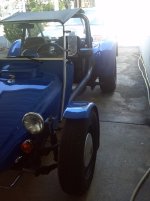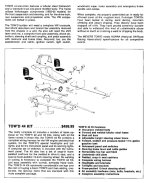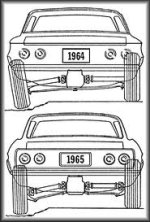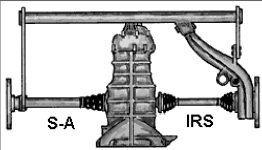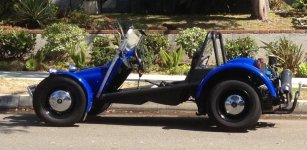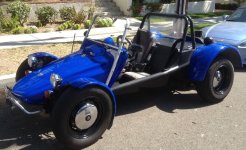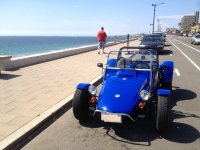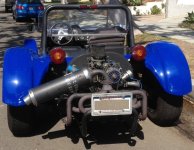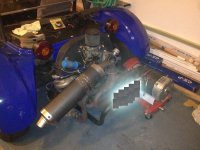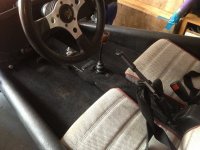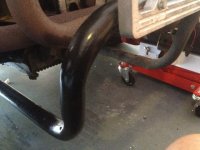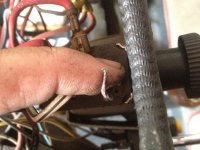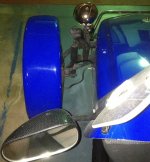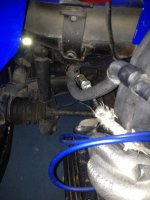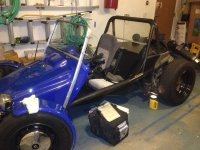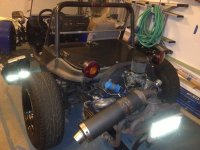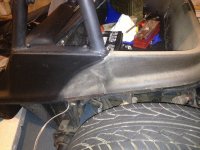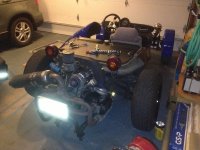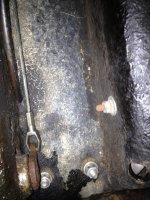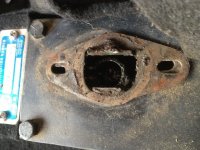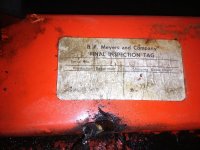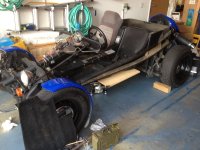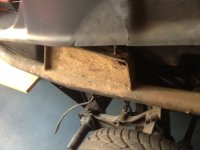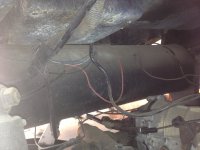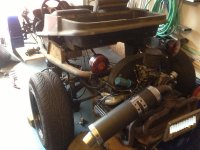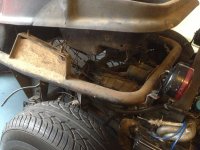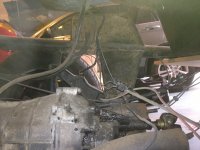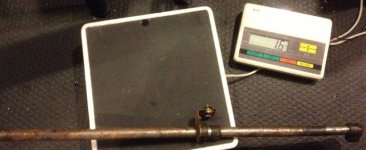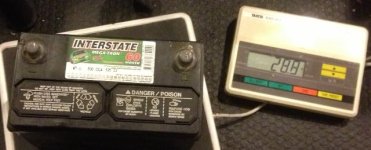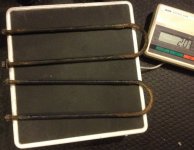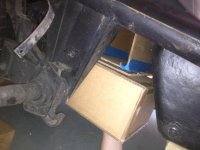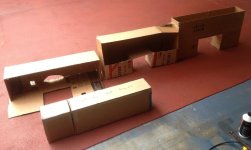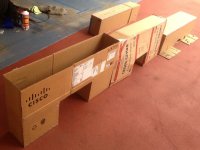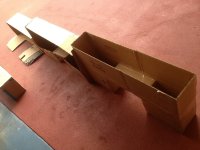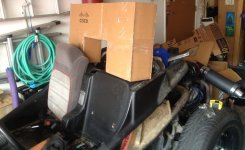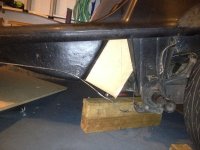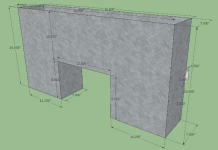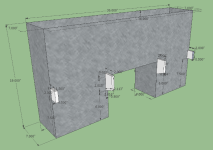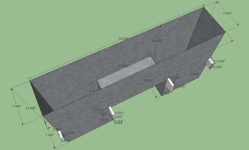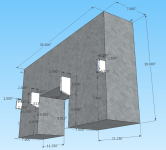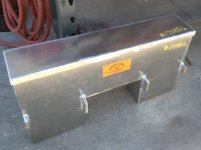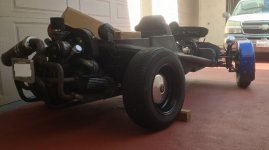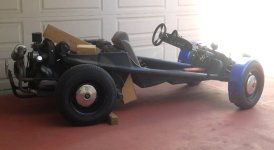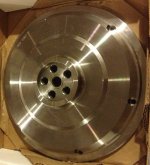oatnet
1 MW
Meet the “Elec-tow’d” Electric Tow’d
(pronounced "Electrode", but with an Elmer Fudd accent)
You may remember the thread on my Electric VW Bus conversion (CLICK HERE), which I built in 2009 and sold last year. I will be bolting-on the 9” DC motor, 180v/500a Kelly controller, and 175v/60ah factory a123 pack, built for the 3500lb Bus, into this 1000lb B.F. Meyer’s Tow’d.

Design Objective:
Auto Manufacturers are designing Electric Cars with long range, trying to make them direct replacements for Gasoline cars. To me, that is like trying to design a sailboat to replace a water-ski boat – it won’t do either job well. 90% of commuter miles today are made by one or two passengers traveling less than 30 miles/day; EV’s excel at this duty cycle, so I think it is a mistake to design them to service the needs of the other 10% - which frankly they suck at.

The superior energy density of gasoline makes it a far better fuel choice if you need to travel long distances, traverse many steep hills, carry heavy loads, or refuel quickly. If you are in the 10% of the population with such a regular duty cycle, then an Electric Car is a poor choice for you until commercially available batteries achieve the power density of gasoline.
However, an ICE needs to shed a tremendous amount of heat and waste gases, requiring a heavy engine block, cooling system, and exhaust system, not to mention complex infrastructure to manage and power these different systems. The weight of all this infrastructure requires a heavy suspension system, and a heavy braking system to stop it, a more powerful engine to move all that weight, and a heavier transmission to convey the extra power from the engine… And because they are all so big and heavy, we need a big chassis to protect us when another ICE bumps into us. If you are one of the 90%, then the complexity and lugging all that excess weight around makes a Gasoline car a poor choice for you.
An EV can get the same performance from much lighter electric motor/controller, which doesn’t require things like liquid cooling or exhaust. Less weight means suspension/brakes/chassis can be lighter too, resulting in a power-to-weight ratio that makes the EV far more efficient; the less mass you have to move, the less energy it takes. Since the infrastructure is modular and less complex, it is cheaper and easier to maintain. Since the EV requires less material to build, it can be cheaper to build than a gas car.
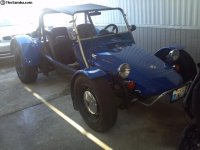
However, Automobile Manufacturers wipe out an EV’s advantages when they include a heavy expensive battery pack rated at > 100 mile range, instead of one that sized to the 30 mile range needed by 90% of commuters. Triple the battery means triple the cost, triple the weight, triple the charge time (often overlooked), yet it still fails to offer the cross-country abilities or the performance of a gas car. To offset the weight of the massive pack, compromises are made, like using too small a motor, or the EV is built on an econobox platform instead of something fresh and purpose-built like the Aptera. Even worse is the hybrid, which adds the complexity, expense, and weight of two drive trains for marginally better gas mileage.
NEV’s are a step in the right direction, but the 25mph speed limit is too restrictive - I can’t use an NEV because my commute ends with the 45mph road my company is located on. We need a new class of EV that is restricted by weight, not speed. Since speed eats range, and range is limited by weight, speed is intrinsically limited.
I believe that the correct answer is an EV that plays to the strengths of electric power. Sizing the pack to a 35 mile range, and leveraging electric power's reduced infrastructure, yields an inexpensive lightweight vehicle, which allows for snappy acceleration and handling as well as a strong top end. I hope to demonstrate my belief with this build.
.
(pronounced "Electrode", but with an Elmer Fudd accent)
You may remember the thread on my Electric VW Bus conversion (CLICK HERE), which I built in 2009 and sold last year. I will be bolting-on the 9” DC motor, 180v/500a Kelly controller, and 175v/60ah factory a123 pack, built for the 3500lb Bus, into this 1000lb B.F. Meyer’s Tow’d.
Design Objective:
Auto Manufacturers are designing Electric Cars with long range, trying to make them direct replacements for Gasoline cars. To me, that is like trying to design a sailboat to replace a water-ski boat – it won’t do either job well. 90% of commuter miles today are made by one or two passengers traveling less than 30 miles/day; EV’s excel at this duty cycle, so I think it is a mistake to design them to service the needs of the other 10% - which frankly they suck at.

The superior energy density of gasoline makes it a far better fuel choice if you need to travel long distances, traverse many steep hills, carry heavy loads, or refuel quickly. If you are in the 10% of the population with such a regular duty cycle, then an Electric Car is a poor choice for you until commercially available batteries achieve the power density of gasoline.
However, an ICE needs to shed a tremendous amount of heat and waste gases, requiring a heavy engine block, cooling system, and exhaust system, not to mention complex infrastructure to manage and power these different systems. The weight of all this infrastructure requires a heavy suspension system, and a heavy braking system to stop it, a more powerful engine to move all that weight, and a heavier transmission to convey the extra power from the engine… And because they are all so big and heavy, we need a big chassis to protect us when another ICE bumps into us. If you are one of the 90%, then the complexity and lugging all that excess weight around makes a Gasoline car a poor choice for you.
An EV can get the same performance from much lighter electric motor/controller, which doesn’t require things like liquid cooling or exhaust. Less weight means suspension/brakes/chassis can be lighter too, resulting in a power-to-weight ratio that makes the EV far more efficient; the less mass you have to move, the less energy it takes. Since the infrastructure is modular and less complex, it is cheaper and easier to maintain. Since the EV requires less material to build, it can be cheaper to build than a gas car.

However, Automobile Manufacturers wipe out an EV’s advantages when they include a heavy expensive battery pack rated at > 100 mile range, instead of one that sized to the 30 mile range needed by 90% of commuters. Triple the battery means triple the cost, triple the weight, triple the charge time (often overlooked), yet it still fails to offer the cross-country abilities or the performance of a gas car. To offset the weight of the massive pack, compromises are made, like using too small a motor, or the EV is built on an econobox platform instead of something fresh and purpose-built like the Aptera. Even worse is the hybrid, which adds the complexity, expense, and weight of two drive trains for marginally better gas mileage.
NEV’s are a step in the right direction, but the 25mph speed limit is too restrictive - I can’t use an NEV because my commute ends with the 45mph road my company is located on. We need a new class of EV that is restricted by weight, not speed. Since speed eats range, and range is limited by weight, speed is intrinsically limited.
I believe that the correct answer is an EV that plays to the strengths of electric power. Sizing the pack to a 35 mile range, and leveraging electric power's reduced infrastructure, yields an inexpensive lightweight vehicle, which allows for snappy acceleration and handling as well as a strong top end. I hope to demonstrate my belief with this build.
.


